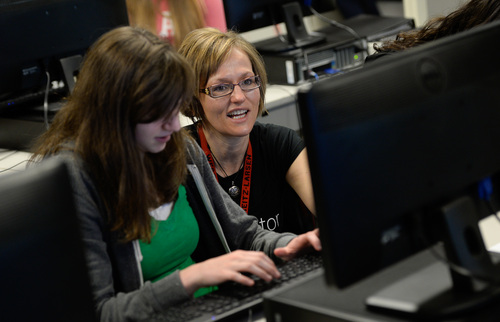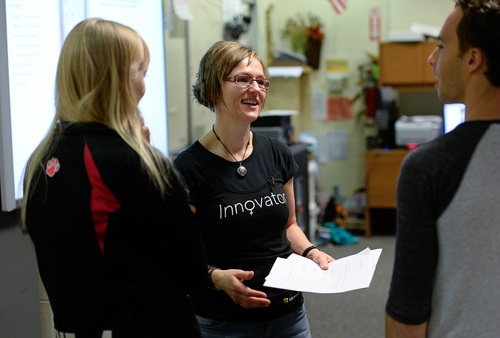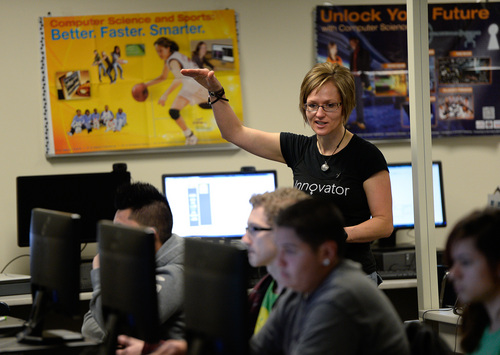This is an archived article that was published on sltrib.com in 2014, and information in the article may be outdated. It is provided only for personal research purposes and may not be reprinted.
For Nicole Reitz-Larsen, the computer is just the beginning.
"We're exploring science, we're exploring other people, we're exploring how to use technology and how to make it connect with math or cultures," she recently told her class at West High School in Salt Lake City. "It's not just, 'Let me teach you what is a computer and how does it work;' it's internalizing it for yourself."
As technology becomes an ever-larger part of daily life, experts say schools are having a hard time keeping up. Less early exposure can mean fewer skills in the growing field, especially among women and minorities.
Reitz-Larsen aims to change that by not only bringing technology into the classroom, but teaching students to use it in new ways that access their critical thinking skills. She's one of five teachers to win a 2014 Teacher Innovation Award from KUED-Channel 7 and The Salt Lake Tribune.
"If you want students to like something, it's better to involve them," said Reitz-Larsen. "That's what it's all about — giving students a voice."
Reitz-Larsen taught German language and business classes for 13 years and "fell in love" with technology through Excel spreadsheets and started incorporating it into her classes. She eventually started teaching courses such as Exploring Computer Science, a course designed in Los Angeles and brought to Utah through Westminster College.
The course is based on research that found having access to technology doesn't mean kids necessarily understand computers. Often in poorer school districts, kids were learning to type and cut-and-paste text rather than code.
Such knowledge gaps add to racial and gender disparities in education for computer science, which is also one of the country's fastest-growing and highly paid career fields. In Utah last year, just four of the 103 students who took the Advanced Placement exam in computer science were girls. Six were Latino; none were black.
But computer science education at West High, which has a student body that is approximately 60 percent Latino, could help change those numbers.
"It's a very exciting time in education, but it's a bit challenging as well," said Mary Ellen Dworshak, career and technical education specialist at West. Even as teaching technology becomes more important and computers in the classroom more common, it's harder to hire people trained to teach it.
West High has been lucky, she said, "to have such an innovative, creative teacher" in Reitz-Larsen.
Reitz-Larsen has taught with hands-on tools such as the MaKey MaKey kit, which turns almost anything into a online touchpad, and has helped connect students with local companies to learn about real-life applications for their work.
On a recent day, Exploring Computer Science students presented web pages they made on everything from Navajo rug weaving to skateboarding. They used math to recreate skateboard tricks virtually and illuminate patterns on traditional rugs and baskets.
Reitz-Larsen also has been able to help other teachers at West integrate technology into their own classrooms in ways that both made sense in the course and engaged students' critical learning skills, such as helping the woodshop instructor use a computer-guided router.
"Teachers are starting to see the availability of what's out there," said Dworshak. "They're finding out they don't have to create the wheel."
Reitz-Larsen is now taking those mentoring skills on the road. In April, she left West to become an outreach coordinator for students in kindergarten through 12th grade with code.org, a Seattle-based nonprofit designed to expand access to computer science, especially among women and students of color. It sponsors national Hour of Code events and offers tutorials online .
It's not only teachers who need some tech encouragement.
"A lot of students aren't real confident," Reitz-Larsen said, though that's starting to change. "Students want to come in during lunch and after school. We're starting to see students get more engaged ... it's been exciting."
Take 16-year-old sophomore Hannah Lopez. She took the class to fulfill a requirement, but "I actually really do like it," she said.
Lopez is also an artist, and Reitz-Larsen helped connect her with a video game developer.
She's communicating with the developer over Google Drive as she works on art for the game, which is designed to help kids understand math.
"If I do pursue a career in art, it'll be in 3-D design with graphics. You're going to have to know how to use math," she said. "Ms. Larsen really helped me out."
Twitter: @lwhitehurst —
Innovation documentary airs Thursday
Five Utah teachers have been selected for KUED-The Salt Lake Tribune Teacher Innovation Awards, which celebrate their creative use of technology in classrooms.
The awards were given in the categories of arts, math, language arts, science and social studies.
The winners will be profiled in a continuing Tribune series this week and in a half-hour documentary airing Thursday at 7 p.m. on KUED-Channel 7.











